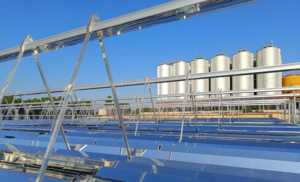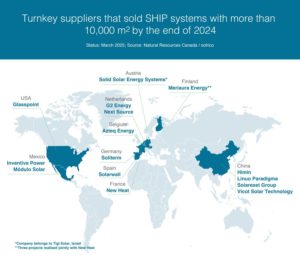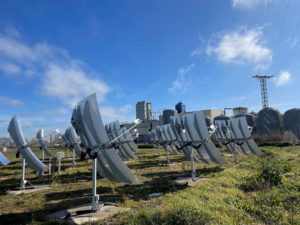Cost reduction potential through prefabricated and standardized balance of plants
July 10, 2023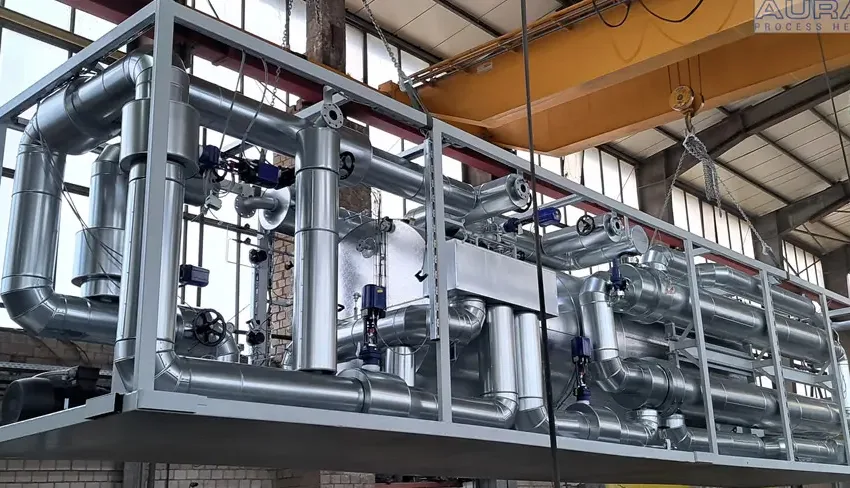
Standardized, modular interfaces for the integration of solar heat into factories can reduce solar heat system costs significantly. The photo shows such a prefabricated so-called balance of plant (BoP) before being shipped to Turnhout in Belgium to connect a 2.5 MW parabolic trough collector field with a chemical factory. The two German companies Solarlite (for the collector field) and Aura (for the balance of plant) designed and constructed the demonstration plant within the German research project Modulus. The results will also be published by the working group “modularization” of the IEA SHC Task 64 Solar Process Heat. One of the first reports from Task 64 looked at commonly used integration schemes in commercial SHIP applications (see pdf link below).
Photo: Aura
Many functions are brought together in the standardized BoP for the system in Turnhout. “Heated silicon oil from three loops with a total of 5,540 m2 of parabolic trough collectors are interlinked and a huge expansion tank is located across the BoP”, explained Dirk Krüger from the German Aerospace Center (DLR), who chairs the Modulus project. Via heat exchangers, the heat is transferred to mineral oil for the client´s heat network. The BoP also includes all the pumps and the control unit. Krüger emphasized that there is an extra electric hard-wired safety chain for all critical control valves, so that if a controller fails, the valves can still be operated to enable a controlled shut down.
| Site | Turnhout, Belgium |
| Client | Chemical factory |
| Aperture area of parabolic trough collector field | 5,540 m2 |
| Thermal capacity of the parabolic trough collector field | 2.5 MW |
| Processes for which solar-heated mineral oil is used in the factory | Solar heat is transferred directly to the factory’s main heat network and is used for multiple applications |
| Solar share of the mineral oil heat network of the client | 20 % |
| Estimated solar yield | 2.2 GWh/a |
| Specific estimated solar yield | 397 kWh/m2 aperture area |
| Range of operation temperature of the solar field | 280 to 380 °C |
| Range of operation temperature of the client’s heat network | 260 to 300 °C |
| EPC for solar collector field | Azteq (Belgium) / Solarlite (Germany) |
| EPC for balance of plant | Aura (Germany) |
| Energy Service Company | Azteq (Belgium) |
| Planned start of heat delivery to the client | September 2023 |
Key figures for the solar industrial heat plant in Turnhout The average yearly output is 2.2 GWh/year according to Azteq this corresponds with around 800 hours of usable sunshine per year. Source: Azteq / Solarlite
Standardized balance of plants
For Aura, the Turnhout plant is the first BoP the company has built for a solar process heat plant. “We would like to include SHIP applications in our portfolio permanently and thus serve a growing market”, said Jakob Leicht, Sales Engineer at Aura.
Aura supplies industrial customers in a wide variety of sectors with complete heat generation systems that run with different energy carriers including electricity, natural gas, hydrogen and waste heat. Leicht has also observed an increasing demand for renewable process heat, including biogas-operated systems. Customers also increasingly ask for electrically heated boilers, which, according to Leicht, “now account for 60% of the boilers we use”. Aura has 85 employees at its headquarters in Germany and five employees at its subsidiary in China, who generated a turnover of EUR 17 million in 2021.
“The advantages of using modularized and standardized solutions for the BoP are evident and widely accepted by the entities involved in the design and implementation of SHIP applications”, stated Andreas Häberle, Director of the Swiss-based SPF – Institute for Solar Technology, who coordinates IEA SHC Task 64. The above-mentioned Task 64 report also makes a contribution to the standardization of BoP. The report assesses several integration schemes in the low and medium temperature range and analyses the reasons for choosing one integration scheme or another.
In a survey of SHIP turnkey providers at the beginning of the year, European companies saw the balance of plant as an area where project costs could be reduced in the short term (see graphic above). Other price components that were ticked by a larger number of companies are construction and installation work as well as planning/design and the collector field.
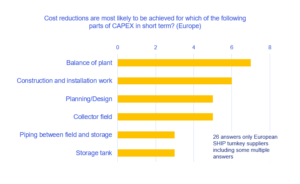
Of the 20 companies that commissioned one or more new SHIP systems in 2022, 17 designed the BoP themselves. In 2022, however, the global SHIP market was characterized by small systems. Krüger assumes that with larger SHIP systems and the trend towards temperatures above 100 °C, more and more specialized BoP providers such as Aura will come into play as partners of SHIP turnkey system providers. With the special know-how from projects like Modulus, European technology providers could have a competitive advantage in global markets, he concluded.
Website of organizations mentioned in this news article:
Modulus
IEA SHC Programme
IEA SHC Task 64
Solarlite / Azteq
Aura
